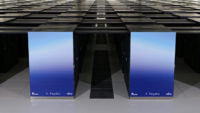ARM-Based Supercomputer Earns Top Spot in Global Ranking
November 20, 2020
The world’s fastest supercomputers are ranked twice a year, and Innovative Computing Laboratory director Jack Dongarra, one academic behind the rankings, noted that the Top500 list of the world’s fastest high-performance computing (HPC) systems is showing “flattening performance” due to the slowdown of Moore’s Law. In the most recent ranking, Japan’s Fugaku ARM-based supercomputer set a record of 442 petaflops. In 2021, however, the first exascale — 1,000 petaflops — supercomputers are expected to appear, including one from the Oak Ridge National Laboratory in Tennessee.
SearchDataCenter reports that Moore’s Law, which states that the number of transistors on a processor doubles every two years, “is now hitting technological barriers.” “There are limits on processor technology, but there is plenty of room to grow,” Dongarra said. “It’s not just about the processor; we are adapting in developing better algorithms and software systems to handle the situation.”

The article notes that, in addition to 1,000 petaflops, an exascale system can reach one quintillion calculations (a one followed by 18 zeroes) per second. At the Max Planck Institute for Meteorology, professor Bjorn Stevens said exascale computing is necessary to process “the massive data sets created by climate science.”
At his opening keynote at the SC20 computing conference, Stevens “stressed that these massive supercomputers have to be accessible to a wide range of people,” including policymakers who can use them to understand, for instance, “how changes in agriculture will affect food security in Africa, or how changes with warming will affect flooding in Northern Europe.” China has three exascale projects in the works and plans to unveil at least one of them in 2021.
In Europe, said Hyperion Research senior advisor of HPC market dynamics Steve Conway, so-called pre-exascale systems — system designs that can scale to exascale — are being rapidly developed.
By the end of 2021, “Europe is due to have eight of these large systems,” including a $160 million 550-petaflop Hewlett Packard Enterprise system in Finland. That system is part of the European Union’s European High-Performance Computing Joint Undertaking. Conway added that, although x86 chips still dominate “and will likely continue to do so for the next five years … the ARM-based approach, such as the one used in Japan, is gaining interest.”
After Japan’s system, at the Riken Center for Computational Science, the second ranked system on the Top500 list is Oak Ridge National Labs’ IBM Power Systems, with “nearly 149 petaflops using its Power9 CPUs and Nvidia Tesla GPUs.”
Related:
Nvidia Debuts New Version of A100 GPU for Supercomputers, ETCentric, 11/18/20
Global Competition Ramps Up in the Semiconductor Industry, ETCentric, 11/18/20
Cerebras’ Wafer-Size Chip Is 10,000 Times Faster Than a GPU, VentureBeat, 11/17/20

No Comments Yet
You can be the first to comment!
Sorry, comments for this entry are closed at this time.